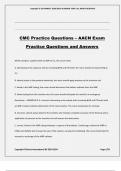Exam (elaborations)
CMC Practice Questions – AACN Exam Practice Questions and Answers
CMC Practice Questions – AACN Exam
Practice Questions and Answers
While caring for a patient with an IABP at 3:1, the nurse notes:
A. decreasing urine output as well as increasing BUN and CR levels; the nurse should increase timing to
2:1
B. absent pulses in the proximal extremity; the nurse...
[Show more]
Preview 4 out of 59 pages
Uploaded on
November 10, 2024
Number of pages
59
Written in
2024/2025
Type
Exam (elaborations)
Contains
Questions & answers
Institution
Prep Tests
Course
Prep Tests
$13.49
100% satisfaction guarantee
Immediately available after payment
Both online and in PDF
No strings attached
Copyright © OLIVIAWEST 2024/2025 ACADEMIC YEAR. ALL RIGHTS RESERVED




